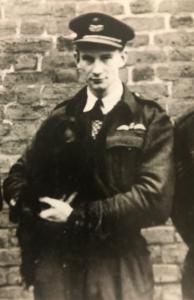
|

|
| Flight Lieutenant Douglas Grant REDMAN (42980) | |
|
13 Squadron Royal Air Force Date of birth: 11th March 1917 Date of death: 2nd June 1942 Killed in action aged 25 Buried at Reichswald Forest Cemetery Collective Grave 28 F 15-17 |

|
| Douglas Grant Redman was born at Collingbourne in Wiltshire on the 11th of March 1917 the second son of Gordon Grant Redman, a gentleman, and Mary Violet (nee Mitchell) Redman, of West Lodge, Upham, Southampton in Hampshire. He was educated at Lancing College where he was in Gibbs House from September 1930 to July 1935. He was appointed as Head of House and as a Prefect in 1934. He went on to the Royal Military College Sandhurst and was commissioned as a 2nd Lieutenant in the Royal Tank Regiment on the 28th of January 1937. He was promoted to Lieutenant on the 28th of January 1940. He transferred to the Royal Air Force on the 7th of March 1940 and was granted the rank of Pilot Officer from the same date. He served at RAF Hamble, RAF Montrose and RAF Old Sarum before joining 13 Squadron at RAF Hooton Park on the 19th of September 1940 where he flew Lysanders. He was promoted to Flying Officer on the 7th of March 1941 and to Flight Lieutenant on the 7th of March 1942. On the night of the 1st/2nd of June 1942, Bomber Command undertook the second 1,000 bomber raid against the city of Essen. The first raid on that scale had been against Cologne on the night of the 30th/31st of May. A total of 956 aircraft were despatched for the operation made up of 545 Wellingtons, 127 Halifaxes, 77 Stirlings, 71 Lancasters, 71 Hampdens, 33 Manchesters and 29 Whitleys. Thirty one aircraft failed to return. When they arrived over Essen the bomber crews had great difficulty locating the target due to low cloud and haze and, as a result, the bombing was very scattered. Damage to the city was light with only eleven houses reported as destroyed and a further one hundred and eighty four as damaged, mostly in the south of the city. A prisoner of war camp was also burned out Fifteen people were killed on the ground with ninety one injured. Eleven other towns and cities in the area also reported damaged, but this too was slight. 13 Squadron was detailed to attack German airfields to distract and where possible, to destroy German night fighters who would be deploying to attack the bomber stream. In all 48 Blenheims were despatched, of which ten made attacks. Douglas Redman and his crew were briefed for the operation by Group Captain Mellersh at 6pm where they were detailed to attack Velno Airfield in eastern Holland. A final briefing took place at 8.30pm. They took off from RAF Wattisham at 10.35pm on the night of the 1st of June 1942 in Blenheim Mk IV Z6186 X1D-C for the operation along with six other aircraft from the Squadron. It is thought that the aircraft was hit by enemy anti aircraft fire over the target as a pilot from 18 Squadron reported that a Blenheim which was flying directly behind his “was badly caught by flak.” The aircraft crashed close to a railway line which ran through a farm at Graft near Rheinberg. The crew was: - Flight Lieutenant Douglas Grant Redman (Pilot) Flight Sergeant Peter Fini Pentland Enna (Observer) Flight Sergeant Thomas Frederick Trimmer (Wireless Operator/Air Gunner) Theirs was one of three intruder aircraft which failed to return from the mission. The Wehrmacht sealed off the crash site and the bodies of the crew were placed in coffins by Herr Gerhard Gardemann, a hotelier and undertaker of Rheinberg, and taken to the mortuary at Rheinberg Hospital from where they were handed over to the Wehrmacht for burial at Anneberg Cemetery. His father received the following letter dated the 10th of June 1942: - “Sir, I am commanded by the Air Council to express to you their great regent on learning that your son, Flight Lieutenant Douglas Grant Redman, Royal Air Force, is missing as the result of air operations on the night of 1st/2nd of June, 1942, when a Blenheim aircraft in which he was flying as captain set out for action and failed to return. This does not mean that he is killed or wounded, and if he is a prisoner of war he should be able to communicate with you in due course. Meanwhile enquires will be made through the International Red Cross Committee and as soon as any definite news is received, you will be at once informed. If any information regarding your son is received by you from any source you are requested to be kind enough to communicate it immediately to the Air Ministry. The Air Council desire me to convey to you their sincere sympathy in your present anxiety.” The bodies of the crew were exhumed by No. 4 Royal Air Force Missing and Enquiry Unit on the 16th of July 1947 and moved to their present location. He is buried at Reichswald Forest Cemetery Collective Grave 28 F 15-17 |
|
| Gibbs House |
Back